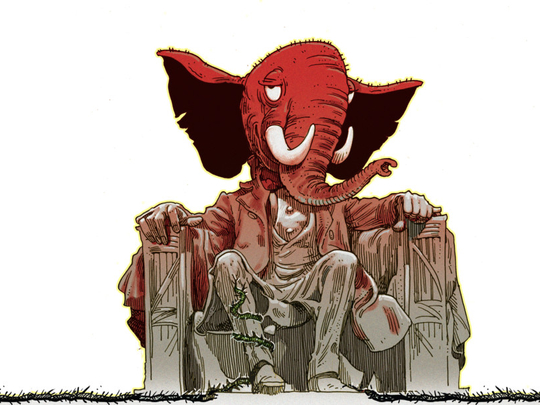
The story line around Donald Trump’s “rise” has got the narrative wrong. It mistakes the man for the movement. While we do need to reckon with what Trump himself means for American politics, we need to reckon even more urgently with what can now be called the “Trumpists”, a solidly right-wing ethno-nationalist voting bloc that has been growing since the mid-1990s.
What points to this story? The numbers capturing the ebb and flow in the belief that United States President Barack Obama is a Muslim and the crisis over the president’s birth certificate. Those are the ones to watch.
During most of 2008, leading up to the presidential election, the number of poll respondents who identified Obama as a Muslim was stable at about 12 per cent. By 2010, however, it had risen to 18 per cent.
And according to Gallup, the release of Obama’s long-form birth certificate in April 2011 brought only to 47 per cent, from 38 per cent, the number of Americans who said that Obama was “definitely” born in the US. Another 18 per cent said only that he was “probably” born in the US. Even after the release of the birth certificate, 23 per cent of Republicans continued to hold the view that Obama was born overseas. These, I suggest, are your Trump voters.
Recent polling has in fact confirmed that Trump, a particularly prominent “birther” in 2010 and 2011, is tapping into this constituency. According to Public Policy Polling, 66 per cent of his supporters believe Obama is a Muslim and 61 per cent think he was not born in the US.
The Trumpists are America’s equivalent of Britain’s United Kingdom Independence Party (Ukip) and France’s National Front — both anti-immigrant, nationalist parties. For the past five years, Trumpists have clocked in at about 20 per cent of the electorate, if one tracks numbers of committed “Obama is a Muslim-ists”. This makes them even more powerful than Britain’s Ukip, which won 12.6 per cent of the vote in May’s parliamentary election. These numbers put the Trumpists on par with the National Front in France, which in March elections took 25 per cent of the vote to the 32 per cent that went to the centre-right party of former French president Nicholas Sarkozy.
The critical difference between America’s nationalist faction and the European ones is that their parliamentary systems register them as “parties”, whereas the US’s two-party model makes it harder to see that what the country is confronting truly is the rise of a new party. Provided, that is, the Republicans do not sell their souls.
If the Republicans can hang on to the convictions that make them the party of Lincoln, America ought to see the party split. For the good of the country, Americans should hope for it.
Two larger shifts in American sociopolitical landscape provide the framework necessary for understanding the Trumpists.
First, there is the dramatic movement of the US toward becoming a majority-minority country, where no ethnic group is in the majority. America has already crossed several Rubicons. In 2011, new births were majority minority for the first time and 2014 was the first year that minority students were in the majority at US public schools. Several states are already majority minority.
Predictions for when the country as a whole will become majority minority continually shift, but there is no question that this will happen within the lifetimes of today’s young people and perhaps even within my own lifetime, if I should be blessed with longevity. It is unsurprising that America’s clear movement in this direction should provoke resistance from those whose well-being, status and self-esteem are connected to historical privileges of “whiteness”.
Second, there is the internet. Digital communications technologies have plainly enabled geographically dispersed people with niche interests to find one another and form communities. For instance, scholars see the recent impact of the Libertarian Party on policy — beginning with successful efforts to thwart banking regulations in 1999 — as being due to the lower barriers to political influence afforded by digital tools of coordination and communication.
Importantly, the first uses of the internet to build political solidarity among those with fringe political interests emerged on the right. The Drudge Report started in 1994 and Free Republic in 1996. The liberal MoveOn was created only in 1998 — to respond to online anti-Bill Clinton efforts — but it did not achieve prominence until 2003. The other major left-leaning sites appeared after George W. Bush’s election: Democratic Underground in 2001, Daily Kos in 2002 and Huffington Post in 2005.
If we look to Europe, again, we can see the effects of these tools, not only on the right but also on the left. Progressive internet activists in Germany, for instance, coalesced into the Pirate Party, which has been able to win seats in four state parliaments as well as the European parliament.
In other words, in America too, one would by now have Trumpists, libertarians and netizens in government, if there was a parliamentary system. But because it doesn’t, there is a very weird, historically important presidential campaign. The weirdness comes from the fact that it is unfolding inside the structure of America’s creaky, 19th-century two-party framework.
The real story, then, is not about this or that candidate, but about precisely how the realignment of US public opinion away from the two major political parties will shake out and about who or what the major parties will sell down the river while trying to save themselves as the “big tents” they need to be to win elections. And the burning question inside this story is whether America’s two-party system can survive the digital era. Or, perhaps better, how to ensure that it does not, so that one can save America’s centre-right party, the Republicans, for the centre.
— Washington Post
Danielle Allen is a political theorist at Harvard University and a contributing columnist for Washington Post.









